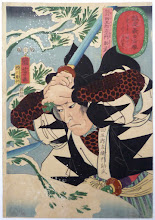Yesterday, Nathan Irving posted that he'd done a bit of simple research on dokkaebi because of my post, and made some interesting suggestions on how to modify the class.
This morning, I randomly found one of my son's books of Korean folklore about a dokkaebi on the floor (along with a few other books). So, even though my Korean isn't great, I read it to him and he translated a couple of points I didn't understand (Korean is very easy to read, even if you don't know what you're reading).
The story is about two brothers. The older is lazy, the younger one hard working. The older brother sends the younger to the mountain to collect sticks and bring back some food. Younger brother (no names given) finds some sesame nuts and collects them along with the sticks. But he gets lost, it gets dark, he finds a run-down old house to spend the night. But he hears a ruckus outside, and hides in a cupboard just before a group of dokkaebi enter. They smash their spiked clubs (bangmangi) on the ground and both food and treasure appear. They begin to feast. The brother is hungry, so cracks a sesame nut. The cracking sound is so loud, the dokkaebi think it's the roof cracking and about to fall in, so they run away. Brother takes the treasure and one of the bangmangi that was dropped, and heads home in the morning.
 |
| The dokkaebi feast |
It's a fairly typical instructive folktale for children. And the dokkaebi in it are rowdy party dudes, but also perform the function of teaching the lazy older brother his lesson.
One of the most famous Korean folk tales is that of brothers Heungbu and Nolbu (I mentioned this in my reply to Nathan). Heungbu is kind and hard working, but poor. Nolbu is fat and lazy, but rich. Nolbu is so stingy he won't even share any rice with his younger brother's family.
Heungbu sees a swallow with a broken leg and nurses it back to health. The swallow may or may not be a spirit creature, but anyway it returns and blesses his house by laying magical eggs. When Heungbu opens the eggs, treasure spills out.
Nolbu hears about this and decides he wants some free money, too. He dresses like a snake to scare a swallow into falling and breaking its leg. Then throwing off the disguise, he nurses the swallow just like Heungbu did. But the bird is not fooled. It does return and lays eggs. But when Nolbu opens them, dokkaebi appear and start trashing his house. Then another egg breaks and floods the house with shit. Nolbu learns his lesson when Heungbu gives up some of his treasure to help Nolbu rebuild.
 |
| The flood of poop, and dokkaebi |
Again, a folk tale meant as instructive for children. And who doesn't love the idea of the rich, greedy, lazy guy getting his stuff ruined by a flood of diarrhea? Anyway, this is where my conception of dokkaebi as dispensers of divine justice comes from.
I just found a third book (my wife, like many Korean women, buys these sets of books from publishers, and most kids never really read all of them) with another dokkaebi story. I should read it a bit more closely (or with my son so he can fill in the gaps), but it seems like a spirit of a mountain is bothered by a bunch of rowdy dokkaebi, and chases them off. Then at the end of the book he gets taught a lesson by a witch (or group of witches? She seems to duplicate in the pictures). Here's a picture from the beginning of the story.
I've made a quick revision of my dokkaebi class. Now they're a bit more trickster-ish, although still primarily a Fighter-type class. And they have some small ability to create items (but not treasure, obviously) when needed, a few times per day. Also some stealth (Halfling hide ability transfers nicely to them to mimic the invisibility caps of folklore). And I kept two "clerical" abilities from before. One is the ability to detect evil at will (which they had before), but only on a 1-2/d6 roll. The other is the ability to summon a spirit companion (Nate makes good use of the Channel Spirit spell to have Finn, his Dokkaebi Mudang (shaman) PC, summon Fang, his "brother" to help fight).






Fascinating stuff. I am not nearly as well versed in Korean Mythology and Folklore as I am Japanese [or even Chinese]. I am very interested in this project of yours, though more for source material than the game itself.
ReplyDeleteD&D remains, for me, not the best way of depicting folklore elements. The system is just not designed that way. Still, this seems far more intriguing than what I usually come across. Well done!
Thanks, Adam. Glad you're enjoying it. Some day I hope to release my campaign setting for Flying Swordsmen and Chanbara in much more detail. FS is pretty bare bones, but I do have a lot more detail on it I could present in a systemless setting guide.
Delete